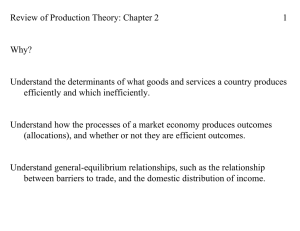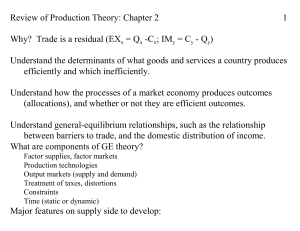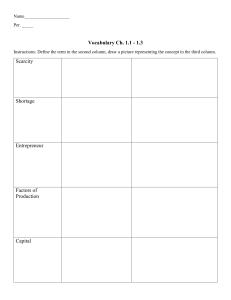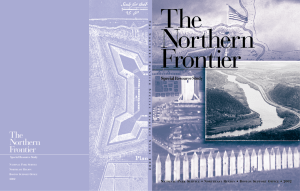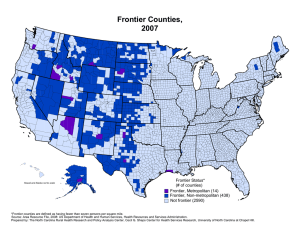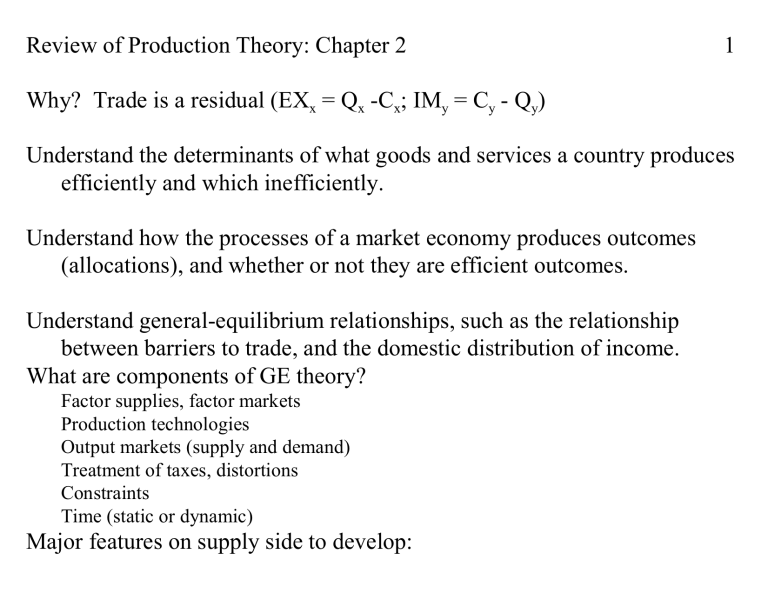
Review of Production Theory: Chapter 2 1 Why? Trade is a residual (EXx = Qx -Cx; IMy = Cy - Qy) Understand the determinants of what goods and services a country produces efficiently and which inefficiently. Understand how the processes of a market economy produces outcomes (allocations), and whether or not they are efficient outcomes. Understand general-equilibrium relationships, such as the relationship between barriers to trade, and the domestic distribution of income. What are components of GE theory? Factor supplies, factor markets Production technologies Output markets (supply and demand) Treatment of taxes, distortions Constraints Time (static or dynamic) Major features on supply side to develop: 1. The production possibility frontier Position: (1) factor endowments (2) real factor productivities Slope: (1) relative factor productivities (2) factor endowments Curvature: (1) constant returns to scale (2) factor intensity effects (3) increasing returns to scale 2. Equilibrium for a single competitive producer Value of marginal product = factor price 2 3. The Edgeworth Box 3 Contract curve, efficient allocations Contract curve maps into PPF Competitive equilibrium implies production efficiency (production point is on the PPF) 4. Competitive equilibrium Establish that a competitive equilibrium is a tangency between the PPF and equilibrium prices. The Production Possibilities Frontier: 4 Max output of Y for given X, holding endowments and technology constant Summarizes information about: A country’s absolute ability to produce goods A country’s relative ability to produce goods How the country’s technologies transform Y into X. Suppose that there is just one factor of production, labor. Assume constant returns to scale where " and $ are some positive constants. Note that " and $ are the marginal products of labor in industries X and Y " and $ give the additional outputs obtained from one unit of labor. What happens as we move labor between sectors? 5 MRT stands for the marginal rate of transformation: 6 the ability of the economy to “transform” one good into the other. The MRT is the slope of the production frontier. Figure 1 The slope is the ratio of the marginal productivities of labor in the two sectors. In the special case where (a) there is only one factor of production (b) there are constant returns to scale The production frontier is linear. 7 The “Economic Size” of the country (absolute ability to produce X and Y) is determined by: (a) The size of the labor force (b) The absolute productivity levels of labor Note the endpoints of PPF: The country’s relative ability to produce X and Y is determined by: The ratio of the labor productivities The Role of factor endowments. 8 Basic case: “specific factors” model. Suppose each good uses a second factor. X uses labor and land (R) and Y uses labor and capital (K). R is of no use in Y and K is of no use in X. Obviously X intensively uses R and Y intensively uses K. Suppose that we have two countries, h (home) and f (foreign). Let both countries have the same endowments of L but h has more R, and f has more K (e.g., US and Japan). Then h PPF is biased toward X and f PPF toward Y. Figure 2 Summary: 9 The slope of a country’s production possibility frontier will depend on: (1) Relative factor productivities in the two industries. (2) Relative factor endowments. A country will be better at producing good X if it has a (1) Relatively better technology (factor productivity) for X (2) Relatively better endowed with the factors used intensively in X Why do we care? The differences in the slopes of the production frontiers determine the optimal direction of specialization and trade. Curvature of the Production Possibilities Frontier 10 Important for: (1) the extent to which countries will specialize in trade (2) the extent to which very similar countries can gain from trade. Case 1: Constant returns to scale, only one factor Production frontier is linear Figure 3 Case 2: Constant returns to scale, more than one factor, industries differ in factor intensities. Production frontier is “bowed out” Figure 4 Law of diminishing marginal product 11 Adding additional units of a variable factor to a fixed factor results in smaller and smaller incremental units of output. Case 3: Increasing returns to scale, one factor Production frontier is “bowed in” Figure 5 12 As we move labor from Y to X (move down the production frontier), we get smaller and smaller decreases in Y output, and larger and larger increases in X output. Alternative representation of scale economies: There are fixed costs needed to begin producing X and Y Figure 6 This is qualitatively similar to the previous case: Points mid way between the endpoint of the production frontier are not feasible production points. The Edgeworth Box: 13 A popular simple model of trade based on differences in relative factor endowments between countries assumes that there are two goods and two factors. Each factor is used in both goods. Goods may differ in factor intensities. Figure 7 , Figure 8 Let X be labor-intensive and Y capital-intensive. The capital-labor ratio in Y is bigger than in X for any w/r. The factor market side of an economy can be represented by an Edgeworth Box. 14 The vertical dimension is the economy’s total supply of capital, and the horizontal dimension is total supply (endowment) of labor. Each allocation implies outputs of X and Y. Slopes of rays from origins to production points are K/L ratios. The locus of tangency points between Y and X isoquants is the locus of Pareto efficient allocations, called the contract curve. Note Y is capital intensive if, at a given set of factor prices, the optimal K/L ratio in Y is greater than in X. Figure 9 , Figure 10 If goods differ in factor intensities, then the production frontier is “bowed out”. Point “A” in the factor box is on the diagonal of the Edgeworth Box. Point “A” is not an efficient allocation, so it is not on the production frontier. What happens to K/L ratios and w/r as we move from C to B? Figure 11 , Figure 12 Summary: 15 A country’s production frontier will be steeper (Y on the vertical axis) as (1) The country has relatively better technology in Y (2) The country is relatively well endowed with factors used intensively in the Y industry. The curvature of the production frontier is: (1) Linear if there are constant returns and one factor (or many factors but no difference in factor intensities) (2) “Bowed out” if there are constant returns, more than one factor, and goods differ in relative factor intensities. (3) “Bowed in” if there are increasing returns to scale and one factor. Competitive Equilibrium: 16 How does the market economy move from the primitives: technology, factor endowments, etc. and come to an outcome (allocation)? An important question is whether or not the market economy does this efficiently, or if there is a need for government intervention. Two goods, X and Y Goods prices are px and py Two factors, L and K Factor prices are w (labor) and r (capital) (1) In competitive equilibrium, firms hire factors up to the point where the value of the marginal product of a factor equals its price 17 The value of marginal product is the price of output times physical marginal product. Figure 13 Dividing the first equation in each line by the second: Figure 14 (2) The ratio of marginal products (MRS) = the ratio of factor prices. This is a fundamental condition for efficiency in factor markets. (3) If all producers are competitive and face the same factor prices, then production is efficient (on the contract curve). But what point on the PPF is chosen? 18 (4) Again use the value-of-marginal-product conditions Figure 15 (5) At any given commodity prices, production is efficient because price ratio is same as MRT. This is fundamental condition for production efficiency in output markets. This is Adam Smith”s “invisible hand” of the market. (6) Move from C to B: what happens to goods and factor prices? A more general approach: many goods and factors Suppose that X0 , V0 chosen at commodity and factor prices p0, w0 Suppose that X1 , V1 chosen at commodity and factor prices p1, w1 For each industry i, profit maximization implies that Sum over all i industries But for each factor j 19 20 Therefore, the outputs X0 chosen at prices p0 maximize the value of production at those prices. Figure 15 , Figure 16 Geometrically, all feasible production points must lie on or below the price hyperplane p0. The price plane is “supporting” to the production set. What should you know? 21 (1) How the slope of c country’s production frontier depends on its technology and its factor endowments (2) How the curvature of the production frontier depends on (a) factor endowments (b) returns to scale (3) At given prices, undistorted competitive economies produce efficiently. this depends on: (a) (b) (c) (d) competition in all markets all firms face the same true factor prices all firms face the same true output prices no externalities
